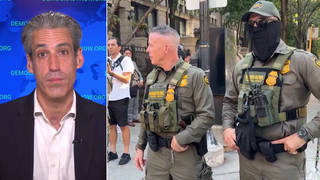
Topics
Guests
- Phyllis Bennisfellow at the Institute for Policy Studies and author of several books, including Ending the US War in Afghanistan: A Primer.
The official U.S. military death toll in Afghanistan has just passed the 2,000 mark. On Monday, a suicide bomber wearing an Afghan army uniform killed 14 people, including three U.S. soldiers, in the eastern province of Khost. Amidst a spate of attacks by Afghan troops on NATO forces, NATO chief Anders Fogh Rasmussen has revealed Western forces may withdraw from Afghanistan sooner than expected. In addition, the New York Times reports the United States has all but written off hopes of working out a peace deal with the Taliban. We’re joined by Phyllis Bennis, a fellow at the Institute for Policy Studies and author of several books, including “Ending the US War in Afghanistan: A Primer.” [includes rush transcript]
Transcript
AMY GOODMAN: We’re on the road in Washington, D.C. We begin today’s show on Afghanistan, where the U.S. has waged the longest war in its history. This week, the official U.S. military death toll in Afghanistan passed the 2,000 mark. On Monday, a suicide bomber killed 14 people, including three U.S. soldiers, in an eastern province of Khost. Witnesses say the bomber was wearing an Afghan police uniform.
Meanwhile, the head of NATO has revealed Western forces may withdraw from Afghanistan sooner than expected. In an interview with The Guardian newspaper, NATO Secretary General Anders Fogh Rasmussen admitted the killings of almost 50 allied troops this year by Afghan security forces has damaged the relationship between the international forces and the Afghan police and military. In addition, the New York Times reports the United States has all but written off hopes of working out a peace deal with the Taliban.
To talk more about the situation in Afghanistan, we’re joined by Phyllis Bennis, fellow at the Institute for Policy Studies. She has written several books, including Ending the US War in Afghanistan: A Primer and Challenging Empire: How People, Governments, and the UN Defy US Power.
Welcome to Democracy Now!, Phyllis.
PHYLLIS BENNIS: Great to be with you.
AMY GOODMAN: Two thousand, the mark has been hit, of U.S. soldiers killed in Afghanistan.
PHYLLIS BENNIS: You know, there’s a big question, for one thing, about when the actual milestone was reached. We’re hearing from some media—the Washington Post, Businessweek said it was this week, this past weekend. The New York Times had actually said it was last August, and CBS News said it was last June. So, even when the count gets there is up for grabs.
But I think what’s more important is that that speaks to the fact that the counting is not the point. The 2,000th U.S. soldier, whether it was this week or last June, is no more or less important than the first or the 17th or the 129th. And what’s particularly left out in all of these counts is the scores of thousands—we don’t know the numbers—of the number of Afghan civilians that have been killed in this war. Since the records began to be kept, which was not until 2007, we know that 12,996 civilians, Afghan civilians, have been counted by the U.S. military just in those last five years. The first six years were not even counted, including the massive carpet bombing of Afghanistan that opened the war on October—beginning on October 7th of 2001.
So we’re faced with this massive level of casualties, giving rise to the kind of anger across society that is leading to these so-called “insider killings.” The U.S. military, of course, has acknowledged that only about 25 percent of those killings actually have anything to do with a, quote, “Taliban infiltrator.” The vast majority, they say, “We don’t know, but it seems to be personal animosity, personal grudges.” What seems clear is that the personal grudges are actually grudges against an illegal occupation that is widely despised throughout the region. So when you see the rising number of casualties—and the casualties have continued to rise throughout the years of the surge and continuing to rise now—that the surge troops, the 33,000 official surge troops that President Obama sent in the first year of his presidency, those are now on their way out, but the number of casualties continues to rise.
The consequences will be the same whether we pull out the troops last week, as I would have preferred, or at the end of 2014: there’s going to be, unfortunately, almost certainly, a violent struggle for power in Afghanistan, very much like what happened the last time a foreign occupation ended. And in that case, when the Soviet Union pulled out, there was a six-year civil war, until finally the Taliban won that war, with the support of the majority of the population at the time, because they promised to bring an end to war. What this is going to mean politically, we don’t know yet. The fact that the U.S. is now saying that they are not prepared to go forward on efforts to bring the Taliban into peace talks does not bode well for the possibility of the war ending sooner rather than later, because what we know is that all wars—and this is, as you said, the longest war in U.S. history—every war ends with some kind of negotiation, some kind of discussion, some kind of agreement. That can be now, or it can be at the end of 2014. It’s not going to qualitatively change the nature of that agreement or what happens on the ground.
What we need to worry about is that what the Obama administration is saying it plans for the end of 2014 is not the withdrawal of all troops and all U.S. paid mercenaries, as we saw in Iraq, when the U.S. was forced out. This time around, we’re hearing what we originally heard about Iraq: we’re going to withdraw the combat troops, meaning we will keep in place the trainers—they’re the ones that are being killed in the largest numbers—we will keep in place the CIA, we will keep in place Special Forces, and we don’t know how many thousands of troops that may mean. There are now 100,000 U.S. paid contractors operating in Iraq, along with 40,000 other NATO troops. Nothing is being said about the contractors. Will they be withdrawn, or will their numbers continue to escalate so we have essentially a continued occupation, but not with uniforms?
In this situation where we’re seeing the so-called green-on-blue attacks, meaning attacks by Afghans on U.S. soldiers, we also have to compare it to what we might call “blue-on-blue” attacks, which is suicide. The numbers of soldiers committing suicide is higher than those being killed by Afghans or those being killed by the so-called enemy. And in that context, I think we have to look again to the reality of what this war has come to represent. It is not bringing freedom and democracy to Afghanistan. It is not making Americans safer. It’s not something that U.S. troops serving in Afghanistan are able to grapple with. And we’re seeing that very stark reality in the high number of suicides.
AMY GOODMAN: And the difference between the major party candidates for president, Obama and Romney, on Afghanistan?
PHYLLIS BENNIS: The difference at this point is rhetorical. President Obama has kept his campaign promise of 2008, when he said he would withdraw the troops from Iraq and he would escalate in Afghanistan. He has done both. Candidate Obama has now stopped talking about Afghanistan this time around. Candidate Romney has said that Obama is not tough enough, but what he has called for has not been different in any substantive way. He has said that we should keep troops there, not pull out right away. President Obama is not pulling out right away, so there’s very little substantive difference.
AMY GOODMAN: And the drone strikes ongoing in Pakistan and in Yemen—at least 35 Americans have gone to Pakistan, part of a CODEPINK delegation, and they’ll join tens of thousands of others, mainly Pakistanis, who will march in Waziristan, at great personal risk. Talk about the escalation of the drone attacks under President Obama.
PHYLLIS BENNIS: The drone attacks have become, in many ways, the signature war of President Barack Obama. This is the war that he has given the most attention to. It has escalated the most dramatically, not only in Afghanistan, but also, as you mentioned, in Yemen, also in Somalia. There are reports of other lower-level drone strikes going on in other countries, as well.
The idea has been that this is cheap and safe, meaning it’s safe for U.S. pilots because they are not in the air. It turns out that it’s neither cheap nor safe. It’s cheap on one level, but when we’re looking at the new Time magazine report, for example, it indicates that it actually costs more to keep a drone, an armed drone, in the air, more in people costs, in personnel costs, and in the cost of the equipment itself, than an F-16. It’s not more safe for people on the ground.
And we know that more civilians are being killed, by huge numbers, rather than the people on the so-called “kill list.” That raises a whole other level of illegality that is being committed by the Obama administration in this period, where the idea that a kill list is being created, apparently being approved by the president himself, that gives authority, without any kind of judicial oversight, to the idea that some people of any citizenship, including U.S. citizenship, can be placed on a kill or capture list and subject to the ultimate punishment, to death, without any kind of oversight by any outside agency.
AMY GOODMAN: Phyllis Bennis, I want to thank you very much for being with us, a fellow at the Institute for Policy Studies here in Washington, D.C. When we come back, we just returned early this morning from Blacksburg, Virginia, from Virginia Tech, in 2007 the scene of the shooting massacre that killed 32 people. What about gun violence as the presidential candidates debate domestic policy on Wednesday night? Stay with us.












Media Options